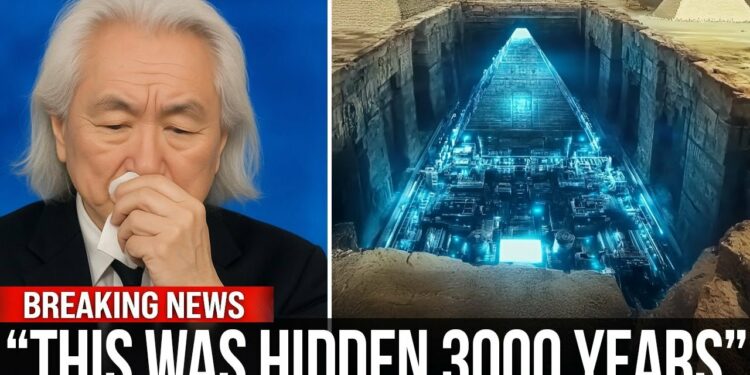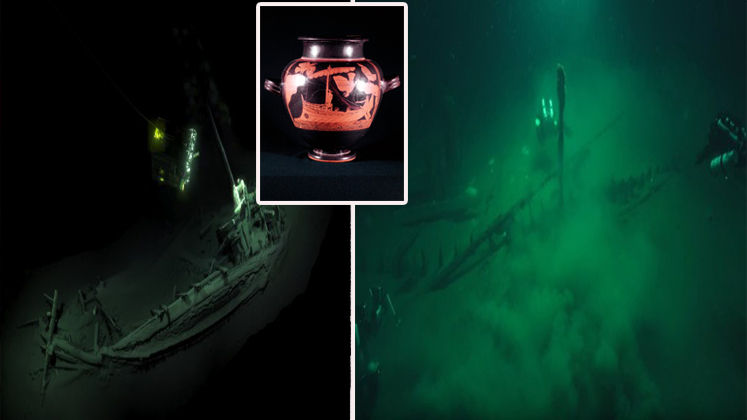For over 4,500 years, the Great Pyramids of Giza have stood as monumental testaments to human ingenuity, shrouded in mystery. Now, a team of scientists claims to have uncovered a sprawling underground city, buried 4,000 feet beneath the Giza Plateau, dwarfing the pyramids themselves. Using advanced radar technology and stunning 3D models, researchers hail this as the most significant discovery in Egypt’s history. Could this revelation rewrite our understanding of ancient civilizations?
Early Exploration of the Giza Plateau
The Giza Plateau has captivated scholars for centuries, its significance rooted in its strategic and geological advantages. Positioned near the Nile River, it provided water and transport routes for heavy materials, while its rocky terrain offered a stable foundation for massive structures like the pyramids. Before the pyramids, the area hosted smaller tombs and mastabas—flat-roofed burial structures—that paved the way for grander projects. The plateau’s spiritual importance, stable ground, and proximity to population centers likely made it a prime location for monumental tomb-building during the Old Kingdom (circa 2500 BCE).
In the 19th century, modern excavations revealed Giza’s role in Egyptian history. Explorers noted the precise alignment of structures, with the Great Pyramid oriented to cardinal directions, suggesting advanced knowledge of astronomy, geometry, and mathematics. These findings fueled debates about the Egyptians’ technological prowess and the possibility of hidden features beneath the sands. Over decades, expeditions mapped the plateau, sparking disputes over timelines, with some suggesting parts of Giza predate mainstream estimates. These questions set the stage for bold modern claims about underground chambers.
Main Structures and Notable Features
The Giza Plateau is home to three major pyramids: the Great Pyramid of Khufu (often called Cheops), the Pyramid of Khafre, and the Pyramid of Menkaure. Built as royal tombs, they form a striking trio, aligned with remarkable precision. The Great Pyramid, the largest, remains a marvel due to its size and construction mysteries. Smaller satellite pyramids, likely for queens, surround them, alongside mastabas, temples, and causeways linking to the Nile or mortuary complexes.
The Great Sphinx, with a lion’s body and possibly Khafre’s face, guards the causeway to the second pyramid. Inside the Great Pyramid, the King’s and Queen’s Chambers, connected by intricate passages and the Grand Gallery’s soaring ceiling, have long fascinated explorers. Advanced scanning, like muon radiography, has detected voids, fueling speculation about undiscovered rooms. Boat pits, once holding solar barques for the afterlife, and workers’ villages reveal the lives of skilled laborers, challenging old notions of slave-built pyramids. Conservation efforts preserve not only the monuments but also ancient roads, noble tombs, and smaller cult structures, revealing a complex cultural landscape.
Rise of Underground Theories
Speculation about hidden chambers beneath Giza dates back centuries. Medieval travelers and guides spoke of secret passages linking the pyramids, often dismissed as folklore. Ancient sources, like Herodotus, mentioned mysterious chambers, keeping these ideas alive. By the late 20th century, ground-penetrating radar (GPR) hinted at subsurface voids, though most were attributed to natural cavities or unfinished construction. These findings left room for theories of a hidden labyrinth protecting treasures or knowledge.
In the 1930s, Edgar Cayce predicted a “Hall of Records” under the Sphinx, capturing public imagination despite archaeological skepticism. Books, documentaries, and alternative theories amplified these ideas, with new scans occasionally detecting anomalies that fueled speculation. Advanced tools like microgravity surveys and thermal imaging, used around the pyramids and Sphinx, suggested walled passages, but mainstream scholars, including Dr. Zahi Hawass, denied evidence of vast networks. This tension primed the public for revolutionary claims about subterranean cities, especially when backed by cutting-edge technology.
The COF Project’s Bold Claims
The COF Project (variously spelled in media) has stirred global intrigue with its claim of a massive underground city beneath Giza. Launched by researchers including physicist Professor Curado (or Corrado) Manga from the University of Pisa, radar expert Filipo Bion from Scotland, and Egyptologist Armando May, the project used synthetic aperture radar (SAR), satellite imaging, and a novel soundwave conversion process to probe unprecedented depths. Their 2022 paper documented smaller voids in the Great Pyramid, gaining modest attention. By converting light signals into soundwaves, their SAR method reportedly penetrated deeper than standard GPR, with AI cross-checking data for accuracy.
Expanding their scans, the team detected thermal anomalies and suspected a network of vertical shafts and chambers extending thousands of feet below the plateau. Their 3D models depict cylinder-like shafts, up to 35 feet wide, descending over 2,100 feet, with horizontal corridors and football-field-sized chambers forming a geometric grid. They suggest water channels, possibly linked to known features like the Osiris Shaft, indicating an intentional layout. Critics argue such structures would have been detected by prior scans or excavations, but the team insists they lie deeper than traditional probes reached, in unexamined bedrock.
Technical Methods and Reported Depths
The COF Project’s confidence stems from SAR combined with light-to-soundwave conversion, allowing penetration of thick rock layers. Satellites directed signals downward, with reflections converted into detailed datasets. Multiple scans from various angles, validated by AI, aimed to eliminate noise. The team claims their technology surpasses standard radar’s limitations, mapping chambers at extreme depths. Skeptics, including Dr. Hawass, question the resolution of such scans, arguing that outlining large structures miles below is implausible. Geologists doubt the bedrock could support such massive tunnels without natural fractures compromising stability.
Skeptical Responses and Expert Critiques
The archaeological community has met the COF Project’s claims with skepticism. Dr. Hawass called them “fake news,” arguing prior scans or drilling would have detected such structures. Radar expert Professor Lawrence Conroy doubts the technology’s ability to map distinct shapes at such depths without distortion. The lack of peer-reviewed studies on the larger claims weakens their credibility, with scholars demanding physical excavations for proof. Critics also note that creating multi-level passages over 2,000 feet deep would exceed the Egyptians’ known capabilities, which relied on copper tools and coordinated labor. The absence of textual references to such structures further fuels doubt, with natural cavities or data artifacts seen as simpler explanations.
Ancient Texts and Symbolic Parallels
Ancient Egyptian texts, like those referencing Osiris and the underworld realm of Amenti, describe subterranean spaces tied to rebirth and cosmic forces. COF’s Armando May suggests these may reflect real structures, with the detected grid and water channels mirroring cosmic patterns. Skeptics view such references as symbolic, tied to spiritual realms like those in the Book of the Dead. Greek historians like Herodotus mentioned labyrinthine structures, possibly near Hawara, but some link them to Giza. These ambiguities, combined with local lore of hidden passages, support theories of lost chambers, though mainstream scholars attribute them to known tombs.
Comparable Underground Complexes Worldwide
Proponents point to global examples of subterranean complexes, like Turkey’s Derinkuyu, a multi-level city with tunnels and ventilation shafts that sheltered thousands. Cappadocia’s underground cities and India’s ornate well complexes demonstrate ancient expertise in underground construction. Modern sites, like Italy’s Gran Sasso laboratory, show the feasibility of deep structures. While Giza’s bedrock poses unique challenges, these precedents suggest a large underground city is not impossible, though critics argue the scale and depth exceed Old Kingdom capabilities.
Engineering Challenges and Possibilities
Building the pyramids required immense planning, labor, and geometric knowledge, likely using ramps and coordinated systems. Digging shafts over 2,000 feet deep, however, would demand advanced reinforcement, ventilation, and water management—challenges skeptics deem insurmountable with ancient tools. Proponents speculate about lost techniques, citing the Egyptians’ stonework expertise, as seen in Aswan’s unfinished obelisk. Proto-hydraulic systems or water channels could have aided excavation, though no records confirm such technology. Alternative theories suggest an older civilization built the tunnels, with pyramids added later, but mainstream scholars demand concrete evidence.
Historical Context, Excavations, and Rumors
Since Napoleon’s 18th-century expedition, Giza has been systematically studied. Early explorers used basic tools, uncovering small passages by chance or local guidance. Modern excavations in the 19th and 20th centuries mapped interiors, but no city was found. Persistent rumors of hidden shafts, fueled by workers and guides, led to scans in the 1960s–1990s, detecting only minor cavities. A 2016 muon tomography study found a 100-foot void above the Grand Gallery, but nothing deeper. The COF Project’s 2023 claims, backed by SAR data, revived these debates, blending science with longstanding speculation.
A Mystery Unfolding
The COF Project’s claim of a buried city beneath Giza challenges our understanding of ancient Egypt. If confirmed, it could reveal a lost civilization or advanced knowledge hidden for millennia. Yet, without physical evidence or peer-reviewed validation, skepticism prevails. The pyramids continue to guard their secrets, reminding us that history is full of surprises. As technology advances and curiosity drives exploration, the truth beneath the sands may one day come to light.






















